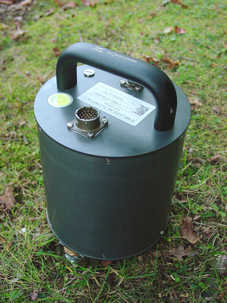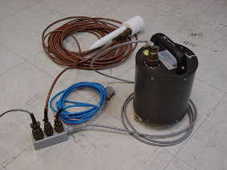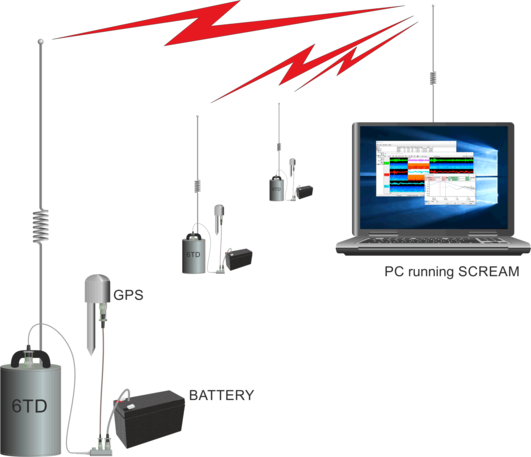
Chapter 2. Introduction
 The Güralp 6TD is an ultra-lightweight digital three-axis seismometer consisting of three sensors in a sealed case, which can measure the north/south, east/west and vertical components of ground motion simultaneously. Each sensor is sensitive to ground vibrations over a wide frequency range (0.033 – 50 Hertz as standard). This frequency response is made possible by advanced force-balance feedback electronics. A built-in 24-bit digitiser converts ground movements to digital data at source with maximum fidelity.
The Güralp 6TD is an ultra-lightweight digital three-axis seismometer consisting of three sensors in a sealed case, which can measure the north/south, east/west and vertical components of ground motion simultaneously. Each sensor is sensitive to ground vibrations over a wide frequency range (0.033 – 50 Hertz as standard). This frequency response is made possible by advanced force-balance feedback electronics. A built-in 24-bit digitiser converts ground movements to digital data at source with maximum fidelity.
The 6TD has a rugged, waterproof design for ease of installation, and requires no levelling or centring as long as its base is within 3 ° from the horizontal. For the best results, however, you should install where possible on a hard, near-horizontal surface well coupled to the bedrock.
Once it is provided with 10 – 28 V power the 6TD will begin operating automatically, measuring and digitizing ground movements and either outputting them to your own recording system, or saving them into internal flash memory. Stored data can be retrieved over a FireWire link to an optional, portable disk drive. Accurate timing information can be taken from a GPS unit connected to the 6TD through a breakout box. Both breakout box and GPS are normally supplied with the instrument.
 Each seismometer is delivered with a detailed calibration sheet showing its serial number, measured frequency response in both the long period and the short period sections of the seismic spectrum, sensor DC calibration levels, and the transfer function in poles/zeros notation.
Each seismometer is delivered with a detailed calibration sheet showing its serial number, measured frequency response in both the long period and the short period sections of the seismic spectrum, sensor DC calibration levels, and the transfer function in poles/zeros notation.
6TD sensors can be delivered in sets of five with GPS and cabling included. Each set is supplied in a “smart” case allowing you to huddle-test the sensors without needing to unpack them.
2.1 State of health information
The 6TD constantly monitors the status of the GPS and timing systems, outputting information in a plain text status stream.
An electronic thermometer also provides regular measurements of the sensor's internal temperature, which are reported in the same stream. The thermometer is calibrated to an accuracy up to ± 0.33 °C, with a linearity of ± 0.5 °C.
2.2 Options
2.2.1 Storage and interfaces
The 6TD can be supplied with up to 16 Gb of internal Flash memory for data storage. The amount you need will depend on the length of your experiment and the sampling rates used.
You can download data from the internal storage:
over a fast IEEE.1394 (FireWire) link with optional power;
using an optional “smart” case, over USB from up to five units at once (see section 3.3);
over the sensor's standard RS232 data port (compatible with Scream! and other Güralp data modules), (although the speed of transfer is limited by the speed of the serial port); or
if fitted, using the Ethernet interface to transfer data over a local area network (but see the following note).
Note: Transfer of stored data over both the serial port and the Ethernet interface is significantly slower than transfer using the FireWire interface. The use of FireWire is always recommended.
Note: When calculating storage requirements, allow at least 50 MB per day of triaxial, 100 sample-per-second data. This figure scales linearly with sample rate so, for example, allow 100 MB per day for 200 sample-per-second data.
2.2.2 Sensor response
The 6TD can be supplied with a response which is flat to velocity from 100 Hertz to any of 1 Hertz, 0.1 Hertz (10 seconds) or 0.033 Hertz (30 seconds).
If you do not require high-frequency data, a low-pass digital filter may be installed at a frequency (below 100 Hertz) that you specify.
2.2.3 Wireless networking
 The sensor can be fitted with an optional 802.11b (“Wi-Fi”) wireless interface in addition to the Ethernet port. This option allows data flow to be established from autonomous installations with a minimum of setting up.
The sensor can be fitted with an optional 802.11b (“Wi-Fi”) wireless interface in addition to the Ethernet port. This option allows data flow to be established from autonomous installations with a minimum of setting up.
For temporary deployments, instruments can be buried in shallow pits with only the antenna above ground. You can then contact each station from a wireless-enabled PC running Scream! without disturbing the instrument, including monitoring real-time data and configuring the digitiser.
More permanent arrays also benefit from wireless technology, particularly in remote areas or where the terrain makes long cable runs impractical.
For example, stations might be installed with high-gain antennae directed towards a visible natural feature which is easier to access.

At this location, which can be up to 500 metres away, a low-power EAM data module might act as a “store and forward” point for the array elements and pass the data on to a higher-bandwidth radio link.
In semi-permanent arrays, a wireless-enabled laptop PC can be set up as a temporary access point for the duration of a site visit.

Note: The PC in this example has been configured to act as a wireless access point (AP). There are many different ways to achieve this, depending on the operating system installed, and a full discussion of this technique is beyond the scope of this manual.